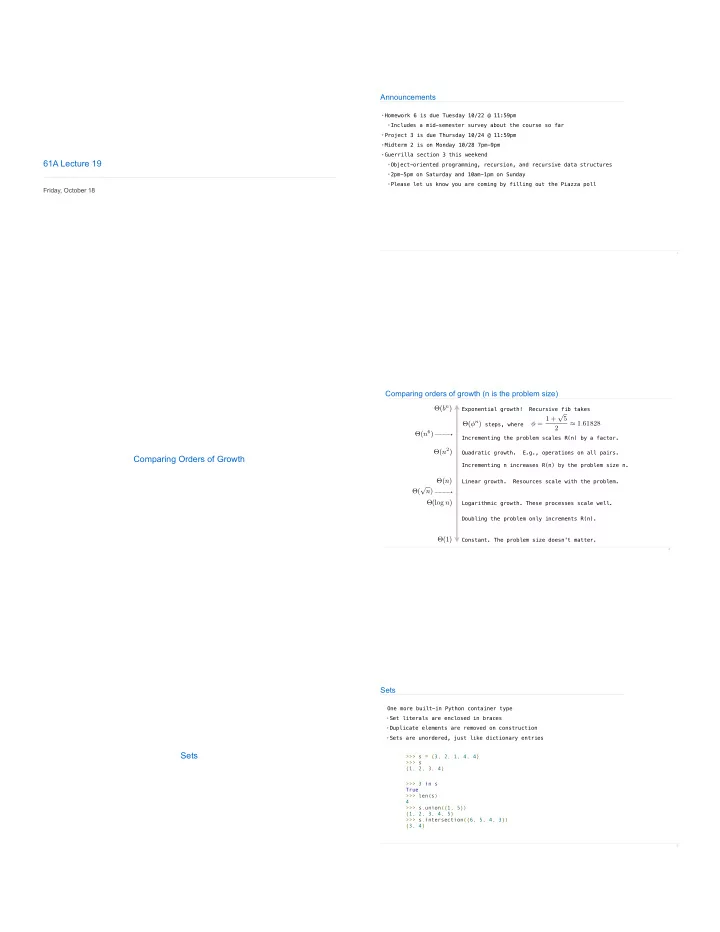

Announcements • Homework 6 is due Tuesday 10/22 @ 11:59pm Includes a mid-semester survey about the course so far • Project 3 is due Thursday 10/24 @ 11:59pm • Midterm 2 is on Monday 10/28 7pm-9pm • Guerrilla section 3 this weekend 61A Lecture 19 Object-oriented programming, recursion, and recursive data structures 2pm-5pm on Saturday and 10am-1pm on Sunday Please let us know you are coming by filling out the Piazza poll Friday, October 18 2 Comparing orders of growth (n is the problem size) Θ ( b n ) Exponential growth! Recursive fib takes √ φ = 1 + 5 Θ ( φ n ) ≈ 1 . 61828 steps, where 2 Θ ( n 6 ) Incrementing the problem scales R(n) by a factor. Θ ( n 2 ) Quadratic growth. E.g., operations on all pairs. Comparing Orders of Growth Incrementing n increases R(n) by the problem size n. Θ ( n ) Linear growth. Resources scale with the problem. Θ ( √ n ) Θ (log n ) Logarithmic growth. These processes scale well. Doubling the problem only increments R(n). Θ (1) Constant. The problem size doesn't matter. 4 Sets One more built-in Python container type • Set literals are enclosed in braces • Duplicate elements are removed on construction • Sets are unordered, just like dictionary entries Sets >>> s = {3, 2, 1, 4, 4} >>> s {1, 2, 3, 4} >>> 3 in s True >>> len(s) 4 >>> s.union({1, 5}) {1, 2, 3, 4, 5} >>> s.intersection({6, 5, 4, 3}) {3, 4} 6
Implementing Sets What we should be able to do with a set: • Membership testing: Is a value an element of a set? • Union: Return a set with all elements in set1 or set2 • Intersection: Return a set with any elements in set1 and set2 • Adjunction: Return a set with all elements in s and a value v Implementing Sets Union Intersection Adjunction 1 2 1 2 1 2 3 3 3 3 3 4 5 4 5 4 1 2 1 2 3 3 3 4 5 4 8 Sets as Unordered Sequences Proposal 1 : A set is represented by a recursive list that contains no duplicate items. def empty(s): return s is Rlist.empty Sets as Unordered Sequences def set_contains(s, v): if empty(s): return False elif s.first == v: return True else : return set_contains(s.rest, v) (Demo) 10 Review: Order of Growth Sets as Unordered Sequences Time order of growth For a set operation that takes " linear " time, we say that Θ ( n ) def adjoin_set(s, v): if set_contains(s, v): n : size of the set return s The size of the set else : R ( n ) : number of steps required to perform the operation return Rlist(v, s) R ( n ) = Θ ( n ) Θ ( n 2 ) def intersect_set(set1, set2): An example f(n) in_set2 = lambda v: set_contains(set2, v) return filter_rlist(set1, in_set2) Assume sets are which means that there are positive constants k 1 and k 2 such that the same size k 1 · n ≤ R ( n ) ≤ k 2 · n def union_set(set1, set2): Θ ( n 2 ) not_in_set2 = lambda v: not set_contains(set2, v) set1_not_set2 = filter_rlist(set1, not_in_set2) for sufficiently large values of n . return extend_rlist(set1_not_set2, set2) (Demo) 11 12
Sets as Ordered Sequences Proposal 2 : A set is represented by a recursive list with unique elements ordered from least to greatest def set_contains(s, v): if empty(s) or s.first > v: Sets as Ordered Sequences return False elif s.first == v: return True else : return set_contains(s.rest, v) Order of growth? Θ ( n ) 14 Set Intersection Using Ordered Sequences This algorithm assumes that elements are in order. def intersect_set(set1, set2): if empty(set1) or empty(set2): return Rlist.empty else : Sets as Binary Search Trees e1, e2 = set1.first, set2.first if e1 == e2: return Rlist(e1, intersect_set(set1.rest, set2.rest)) elif e1 < e2: return intersect_set(set1.rest, set2) elif e2 < e1: return intersect_set(set1, set2.rest) (Demo) Order of growth? Θ ( n ) 15 Tree Sets Membership in Tree Sets Proposal 3 : A set is represented as a Tree. Each entry is: Set membership traverses the tree • Larger than all entries in its left branch and • The element is either in the left or right sub-branch • Smaller than all entries in its right branch • By focusing on one branch, we reduce the set by about half 9 def set_contains(s, v): 7 3 5 if s is None : 5 return False elif s.entry == v: 3 9 3 9 1 7 3 9 return True elif s.entry < v: 1 5 11 5 9 1 7 11 return set_contains(s.right, v) 1 7 11 elif s.entry > v: return set_contains(s.left, v) If 9 is in the 11 set, it is in this branch Order of growth? 17 18
Adjoining to a Tree Set 8 8 8 8 5 9 7 None 3 9 7 11 None None 1 7 11 More Set Operations Right! Left! Right! Stop! 5 9 7 8 8 3 9 7 11 8 1 7 11 8 (Demo) 19 What Did I Leave Out? Sets as ordered sequences: • Adjoining an element to a set • Union of two sets Sets as binary trees: • Intersection of two sets • Union of two sets • Balancing a tree That's all on homework 7! 21
Recommend
More recommend